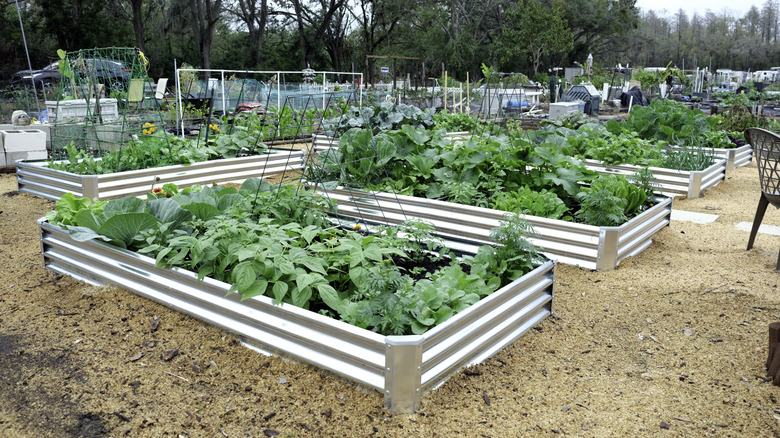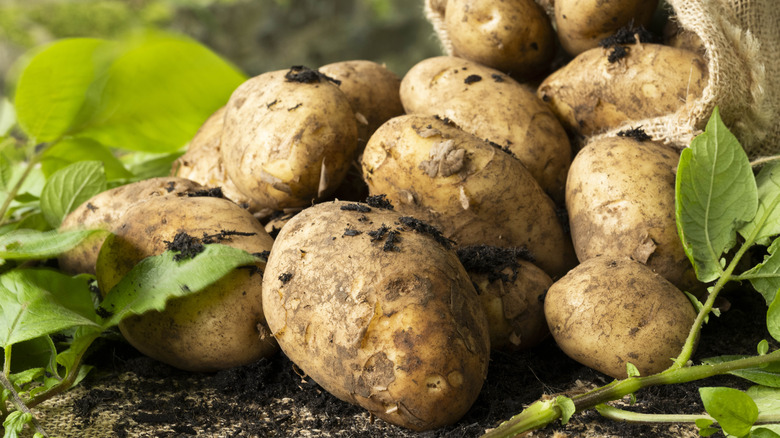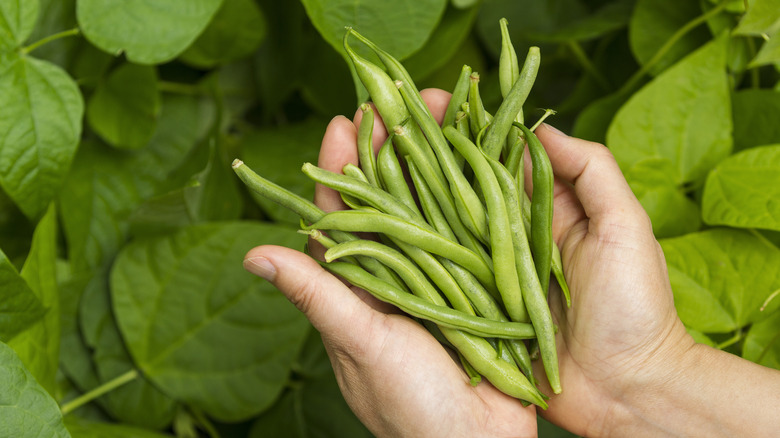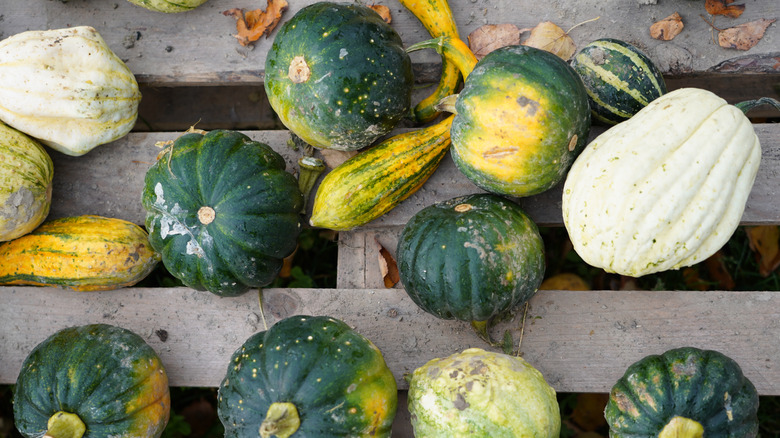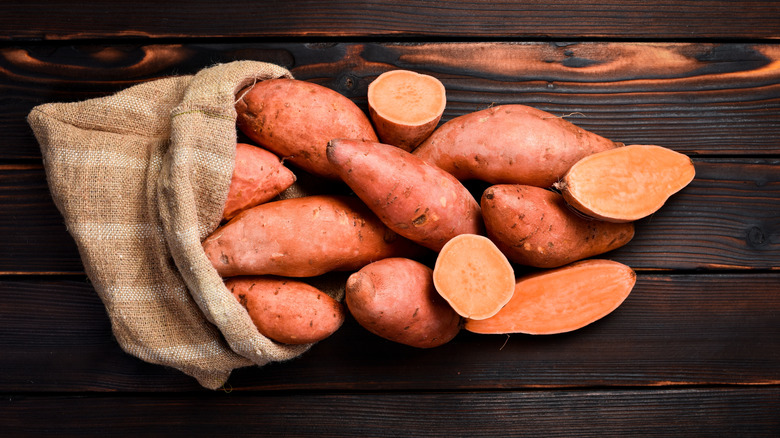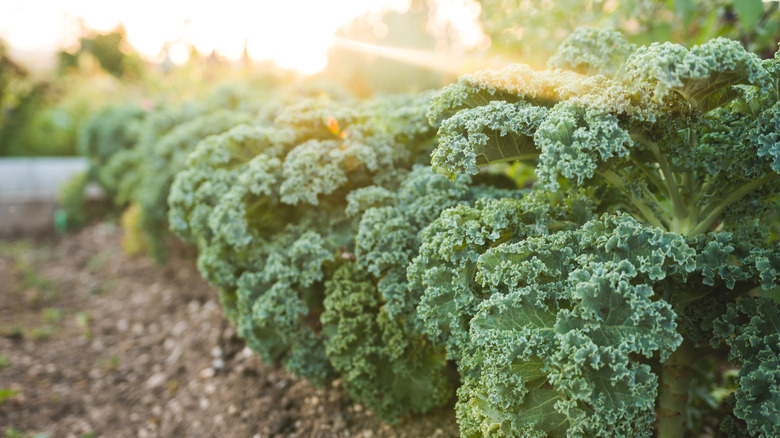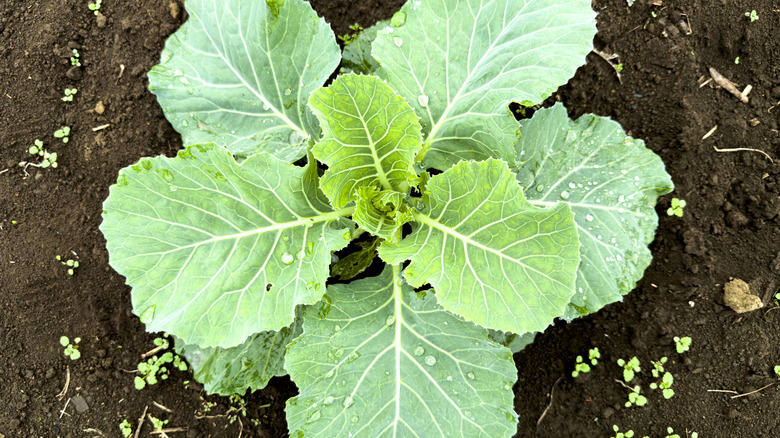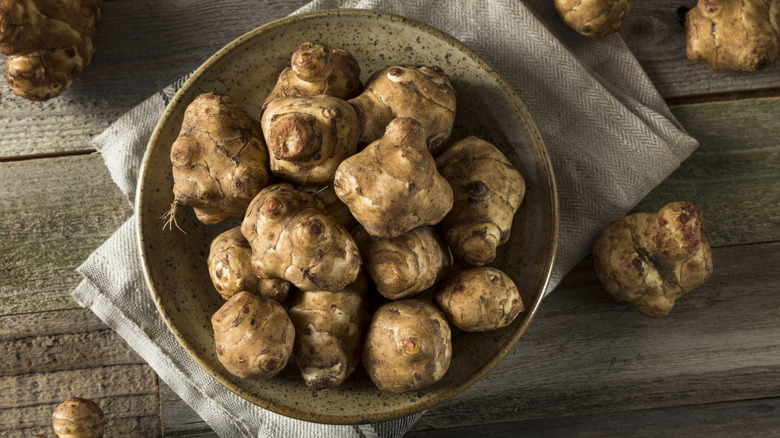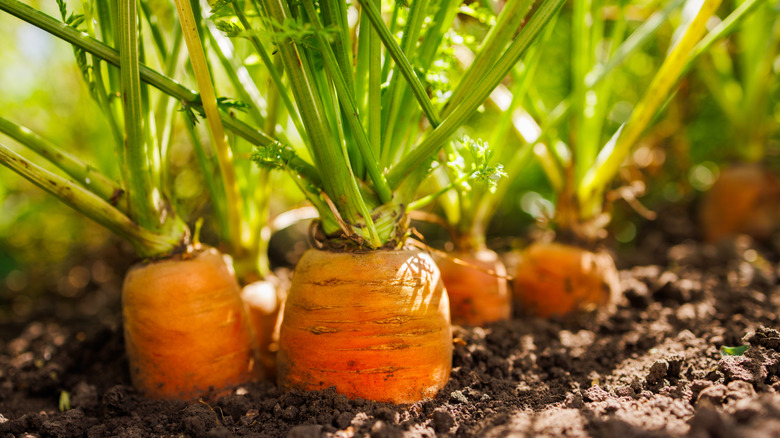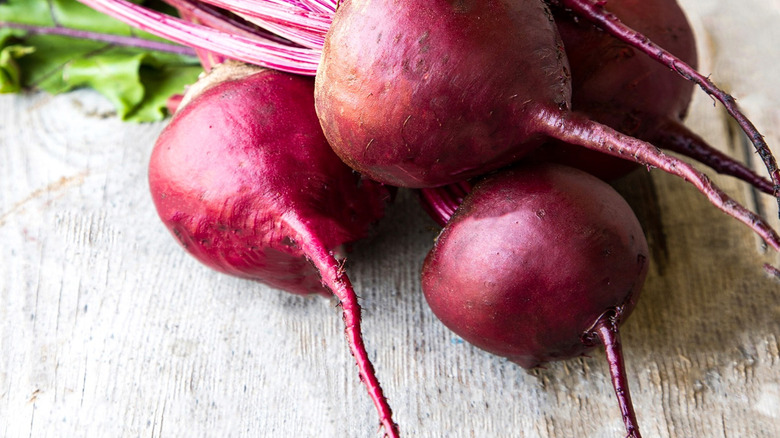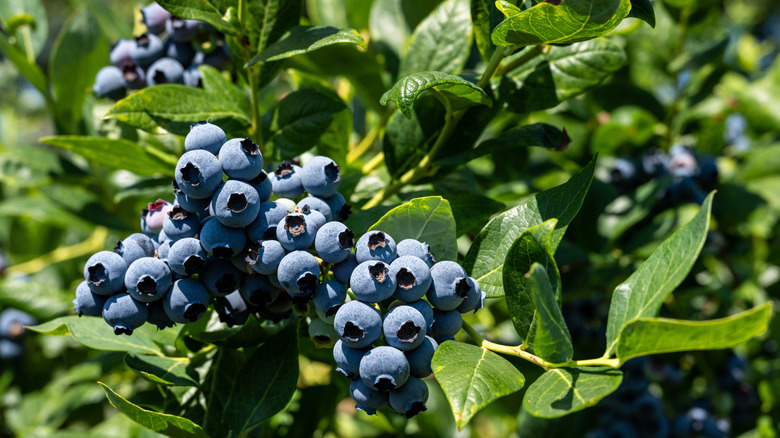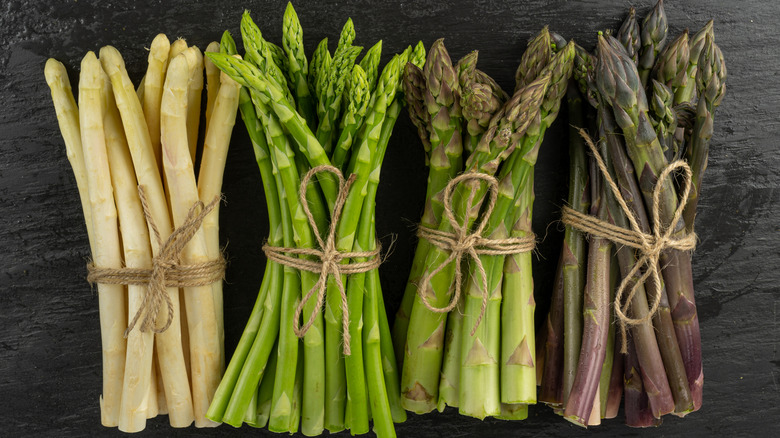14 Essential Crops That Belong In Every Survival Garden
Survival gardens are an important way for a household to grow food to live off of during emergencies. The fruits and vegetables grown in a survival garden can help supplement a household's meals during a food shortage, or help them save money when it's time to start budgeting. With a large survival garden, you might be focused on providing ingredients for entire meals all through the year. But even a smaller vegetable garden can help you produce a significant harvest to help make your meals less expensive. These gardens are also a good introduction to growing your own food, and can be filled with plants you and your child can grow together.
So, what are the best options for your survival garden? Generally, you want to focus on growing crops that are high-yield, store well, and are very filling. You'll also want a few options that provide you with a good amount of vitamins and minerals. Though you can certainly customize it to your own unique needs, a survival garden is designed to help you out when food runs short; this means that many will have crops you can, well, survive off of for a time. We'll cover 14 of the best crops that you should be adding to your survival garden, and the basics of what they'll need to grow — as well as their nutritional info and culinary uses. From potatoes to blueberries, here are some of the survival garden essentials that aren't challenging to grow.
Potatoes are a survival must-have
Potatoes are a staple survival garden food, and they're probably one of the first things most people mention when they talk about starting a survival garden. In a pinch, you could technically survive off of solely potatoes for a short time frame — but even in the long term, they're a good source of carbs and vitamins. They'll fill you up quickly, provide lots of energy, and are easy to cook with. Eat them on their own or toss them into a variety of delicious dishes — you can stick with your favorite type of potato, or grow several different varieties. Russet and Yukon Gold potatoes are known for storing well, are sizable (especially Russet potatoes), and are extremely versatile. To store them, just pop them in a cool and dark place — a cellar or pantry is ideal. Make sure you avoid washing them until you're ready to use them, too.
Plant your potatoes in the ground when they're tubers, and make sure they're about 3 to 4 inches deep. Water them regularly. You can also grow potatoes in containers for an easy harvest. Potatoes are great when planted in the spring, but because they're a cool-weather crop, they can also tolerate fall temperatures (best for planting Zones 9 and 10). Make sure they're planted in well-draining soil — and if you have a small survival garden, you'll need to be prepared to move your potato-planting zone or swap out your garden bed soil after harvest season, because potatoes shouldn't be planted in the same spot year after year.
Grow beans for harvesting and storage
Beans are a broad category, but virtually any type of bean is going to be fantastic for a survival garden. There are benefits to each kind of bean; bush beans and pole beans grow vertically, so they take up less room in your garden for a higher yield. Dry beans are fantastic for long-term storage, and are a source of protein.
Green beans can be canned, pickled, or eaten fresh. This makes them a delicious summer crop that packs lots of health benefits, and can even be preserved to add to your pantry. Dry beans, on the other hand — like pinto, black beans, or lima beans — are left to dry out before even being harvested. Then, you can shell them and store them — and they last for ages. These types of beans are fantastic for helping you get through winter, but they do take a bit of effort to shell. Bush, pole, and lima beans are all warm-weather crops, but they do well in all types of soil. You can expect a harvest of up to 10 pounds of beans per 10 feet of bush bean row, and up to 12 pounds of beans for pole types; perfect for enjoying throughout summer.
Squash is a spring and fall staple
There are so many different types of squash that you can safely rely on throughout the year. Some squash varieties, like butternut or acorn squash, can be grown in early fall, as long as they can be harvested before the first frost. Most squash are also fantastic for planting in spring or early summer; spaghetti squash or yellow squash are other varieties that can be grown during these times. Don't forget about pumpkins, too!
Squash is suitable for a wide range of dishes, and it's fairly easy to store. You'll likely want to chop it up and freeze it, or you can try canning some squash (like pumpkin) — just make sure to check if it's safe to do so first, as summer squash varieties cannot be canned. Squashes like pumpkin are extremely versatile, and can be used in an enormous range of sweet or savory dishes. Winter squashes in particular are a good bet, because they tend to be firmer, with a more substantial texture than summer squash, and are also a good source of protein, vitamins, and fiber.
Most types of squashes will contain a lot of seeds when mature. While these are delicious to snack on, they're also good news for planting, too. Learn about the best way to save your pumpkin seeds to plant next year, or let a pumpkin rot in your garden and you'll have a whole patch come next autumn. Any survival garden you don't have to worry about is a good one.
Plant corn for fiber and grain
Corn is a wonderful survival garden crop because it's chock-full of fiber. You can eat corn on its own — whether cooked or raw — and use it in a number of dishes. It's also a fantastic base for many cooking staples, such as tortillas. It offers antioxidants, soluble and insoluble fiber (both of which are essential for gut health), and some varieties can be used for grain, while others are used as a vegetable. Matured dent corn (or field corn) is what's used for corn flour — harvest some sweet corn as soon as it's ripe, on the other hand, and you can have some delicious corn on the cob.
Sweet corn is best for eating, and is grown during the summer. Make sure to water it deeply and often, as corn needs at least an inch of water every week. Dent corn is used as grain, and has much of the same requirements as sweet corn — but you'll need to let it dry out before harvesting. Both of these staples are fantastic for a survival garden.
Sweet potatoes give long-lasting energy
Sweet potatoes are known for being an especially stable source of energy. They've got good carbs, fiber, vitamins, and minerals andare also higher in protein than other kinds of potatoes — you might even spot them in high-protein desserts or breakfast smoothies. Additionally, sweet potatoes produce edible leaves — just another handy ingredient to achieve from a small survival garden.
Sweet potato sprouts are best planted in spring, after the last frost. You can even grow them in containers for a year-round harvest. The vines from planted sweet potatoes can spread up to 4 feet, so prepare to have a very leafy ground cover while your potatoes grow. Once they're ready to harvest, they can be pulled out of the soil in clusters, ready to be prepared for long-term storage. As a bonus, they're pretty drought-tolerant!
Besides cutting and freezing your sweet potatoes, you can also dry and cure them. A cured sweet potato (which means its left for about 10 days in an area with a constant temperature of between 75 and 80 degrees Fahrenheit) will stay good for many months in a root cellar, though you can also pop it in a cool, dark place to store it for up to a month. Their propensity for long-term storage makes them a fantastic option for a survival garden — not to mention the fact that they're good for everything from mashed potatoes to sweet potato pies.
Kale will survive fall frosts
Kale is considered quite easy to grow, and it's extremely rich in vitamins (such as K, C, and A), minerals, and iron. Its leaves are conducive to whatever method you prefer for cooking; whether you steam, sautée, make kale chips by roasting it in the oven — it's even safe to eat raw, if you so choose. Most importantly, kale is very frost-tolerant.
Though it's recommended to plant kale in the early spring, a few weeks before the last frost, you can also get away with planting it during the fall in some planting zones. That's because kale can actually become sweeter and tastier once it's been exposed to a bit of frost. You can also plant kale during the late summer. Play your cards right, and you might just enjoy a few separate kale harvests within one year. Just try to give your kale access to as much sunlight as possible, because this will help their leaves grow larger. Feel free to allow your kale to grow freely in your garden, or plant it in a garden bed for a more contained survival garden.
Tomatoes can give a high yield for the amount of space they need
Tomatoes aren't the most filling survival crop, it's true. But if you've got just a little space in your garden, they're a good thing to plant, because they're a fantastic culinary ingredient. Sauces, condiments, and soups can all benefit from tomatoes — they add flavor and form to your favorite pasta dish or fresh sandwich. Canning up your tomato harvest will ensure it lasts all year. Tomatoes are known for being one of the easiest plants to grow for beginner gardeners. You should also yield quite a decent harvest per plant, and since they grow on vines, they don't take up a lot of space. Just make sure to give them full sun, if possible, and ensure that they're planted in well-draining soil.
You can choose which tomato to grow based on your own personal needs. You might want a tomato that grows quickly, or choose to grow ones that are especially large (like beefsteak tomatoes). Maybe you want cute little cherry tomatoes for salads or snacking. Roma tomatoes are fantastic for canning. Some varieties are disease-resistant as well, which can be a benefit for a survival garden (check out Cornell University for the full list).
Collards are rich in vitamins and minerals and can tolerate frost
Much like kale, collards are full of vitamins (like vitamin K and A) and minerals. They are also a good source of calcium and iron — the latter of which can be especially important for a survival garden in times where you might not be able to have much meat in your diet. Collards should be grown during the cool seasons (spring or fall) and can tolerate frost. You can harvest collard greens at several different growth stages, from young leaves to fully matured ones — the young leaves are great for salads, while mature ones are tougher and best for cooking with.
Make sure the soil you're growing your collards in has plenty of nitrogen, so they can achieve the best growth. If you harvest the collards young and cut them back, it will grow back and can be harvested again. Once you're ready to harvest the leaves, prepare them to be frozen by cleaning them and blanching them.
Sunchokes are easy to add to your garden
Survival gardeners love sunchokes, as they can grow virtually anywhere in the U.S. with easy care. They're native to North America and are extremely fibrous. Plant them during the spring and watch your sunchokes bloom. Though the little yellow blooms generally aren't recommended for eating (some choose to use them for teas), young sunchoke leaves can be harvested for cooking. Never eat them raw — boil them first, as this will remove the exterior hairs from the leaves and make them edible.
Harvest your sunchokes in October, just after the first frost. You'll need to take out the entire root system of the full plant — you're after the tubers — they kind of look like ginger root. Expect an average 5 pounds of them per sunchoke plant, which will certainly last you some time. Store them in a root cellar, or alternatively just keep them in the ground until you're ready to start eating them.
Try adding carrots to your survival plot
Carrots are another straightforward option for a survival garden. They're delicious, provide a high amount of many essential vitamins, and are very versatile — juice them, put them in your smoothies, add them to savory dishes, and more. Grow your carrots in well-draining soil, and make sure to water them regularly. After your carrots have seeded, expect to be able to harvest them in about 70 days or longer. You can allow carrots to stay in your garden over winter — just make sure that you mulch them to keep them warm, and continue to harvest them throughout the season as you plan to use them.
Pop the leaves off of your carrots and store them long-term in a root cellar. You can also store them for up to a month in your fridge, orcut and freeze them to help them keep for longer. Alternatively, try pickling them for a brine-y snack. Don't forget to use the leaves once you've taken those off, too — they're totally edible and are great when used in sauces, as a dried herb, or even in salads.
Beets can give a bountiful yield
Like with many other vegetables that grow underground, the leaves of your beets are edible — which is always a bonus for a survival garden. Planting a 10-foot row of beets could net you 10 pounds of them come harvest time. Store your beets by freezing them (they'll stay good for up to 10 months), pickling them, or pressure canning them. Save your beet leaves for the next time you make soup or a smoothie — and for those beautiful red roots, slice them up raw for salads, or cook them into hummus, sauces, soups, and stews.
Start your beets anytime from March to June, and plant them in late spring to summer. They can take as little as 50 days to be ready for harvest when planted from seed, or 35 to 45 days when grown from transplant. There are many different types of beets, all of which will range in color and flavor. Beets are underrated in terms of versatility.
Turnips are quick-growing and delicious
Turnips are yet another option for a hardy and fast-growing survival crop. They're also a fantastic source of fiber, so they're an alternative option that will help keep you full. They're high in vitamin C and vitamin B6. You can eat the bulbs and the leaves, which gives you even more opportunities for harvest and preparation.
Turnips are good crops for cool weather. They can tolerate frost, which makes them suitable for fall or spring planting. Just make sure that they get a good eight hours of sunlight so that they can grow large and healthy. Best of all, you might be enjoying mature turnips in as little as 40 days — which is a fantastic quick-growing crop for a survival garden.
Blueberries pack a nutritious punch and don't need a lot of space
Berries are a great survival garden option — you need a little bit of fruit in your garden, after all — and blueberries in particular are good at being high-yield. They're pretty easy to take care of, and your bushes will likely grow back stronger and produce more berries year after year. Store them by canning them up so they can last all winter, snack on fresh blueberries or use them in a pie, and pop them in the freezer for smoothies or a frozen treat. Blueberries are a fantastic source of antioxidants and minerals.
How you grow your blueberries will depend on the type of bush you purchase and where you're growing them. Plan to ensure your blueberries receive some full sun throughout the day and get ready to increase your watering routine in spring and summer, generally. On average, you can expect between 3 and 5 pounds of blueberries per mature bush, though you might get much more than that depending on the type of bush being grown (highbush vs. half-high blueberries).
Asparagus will grow back year after year
Asparagus is a good survival crop because it lasts for such a long time. The shoots that you see on your plate are not the entire plant — there's a whole plant system that can survive on its own for up to a whopping 20 years. They are super nutrient-dense, chocked full of vitamin K, fiber, and antioxidants.
You'll plant your asparagus crowns a couple of weeks after the last frost of the season. During the year that you plant your asparagus, you'll have to avoid harvesting any of the shoots, so prepare to give up some space in your garden without any yield for the first year. It's well worth it; however, you can harvest for a few weeks in year two, and then two months by year three. Just cut the spears right off the plant as they come out of the ground.
